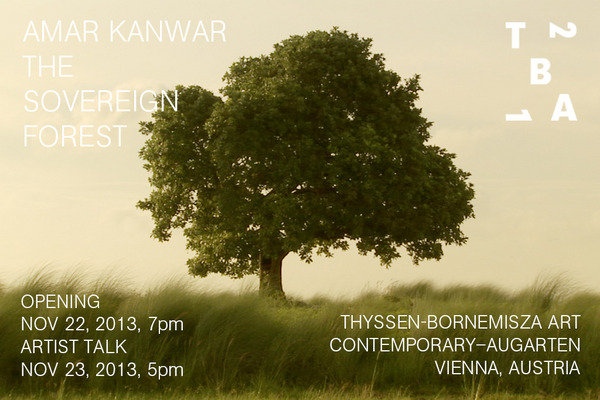Amar Kanwar
dal 21/11/2013 al 22/3/2014
Segnalato da
21/11/2013
Amar Kanwar
Thyssen-Bornemisza Art Contemporary - TBA21 Augarten, Wien
Kanwar's filmic oeuvre of the past two decades has presented a profound interrogation of the politics of power, violence, and justice specifically focusing on the Indian sub-continent. "The Sovereign Forest" renders visible what has hitherto been hidden and suppressed within the site of this "modern war."

"The validity of poetry as evidence in a trial; the discourse on seeing, on understanding, on compassion, on issues of justice; sovereignty and the determination of the self—all come together in a constellation of moving and still images, texts, books, pamphlets, albums, music, objects, seeds, events and processes."
–Amar Kanwar
Amar Kanwar's filmic oeuvre of the past two decades has presented a profound interrogation of the politics of power, violence, and justice specifically focusing on the Indian sub-continent. His latest work, The Sovereign Forest (2011–) emerges from the conflict in Odisha, India, between local communities, the government, and corporations. For more than a decade Kanwar has been filming the industrial interventions that have reshaped and permanently destroyed parts of the state's landscape. Since the 1990s Odisha has become a battleground on issues of development and displacement, as national and international corporations have established large-scale mining and industrial sites in various parts of the traditionally agrarian state. The resulting conflicts between local communities, the government, and corporations over the control of agricultural lands, forests, rivers, and minerals have led to the forcible displacement of indigenous communities, farmers, and fisherfolk while engendering an ongoing regimen of violence that is often unpredictable and invisible.
The Sovereign Forest renders visible what has hitherto been hidden and suppressed within the site of this "modern war." Engaging the viewer in manifold ways of seeing and comprehending, the work harnesses a set of propositions that investigate the notion of "poetry as evidence." Kanwar's two central films, titled The Scene of Crime and A Love Story as well as the constellation of objects that accompany them orchestrate actual found and collected images, traces, records, fables, and personal stories in multiple vocabularies to surpass fact and reveal a richer, more fluid, and poetic perspective on reality and on "the meaning of what is happening."
Challenging the institutional limits of the archive, this library of evidence contains the following elements: formal pictorial evidence; 'found' pictorial evidence; the evidence of the timeless local fable, scripted and visible in printed words and woven together with embedded personal objects in the large handmade book titled The Counting Sisters and Other Stories; formal factual evidence and the legal archive from an old scene of crime and a completed trial in The Prediction; a similar large handmade book with no words, with printed chapter titles but without any texts within, titled The Constitution; the evidence of 272 varieties of indigenous rice seeds, indexed and presented in the language of a formal archive but also indexing and presenting generations of noncommercial, non-marketed, unrecorded intangible oral knowledge; the evidence of personal contributions made to The Sovereign Forest. Thus the exhibition shifts from modality to modality, from multiple modes of expression that undo the divisions of formal, found, factual, objective, fictional, narrated and invented records in the new library of evidencing that acts to delegitimize or rather re-legitimize the terms of definitions.
A little more than a year ago, on August 15, 2012, The Sovereign Forest opened for public viewing at the Samadrusti campus in Bhubaneswar, Odisha, as a permanent installation presented in collaboration with an activist media organization. Since then, many visitors have come, stayed, shared views and insights, and occasionally contributed more evidence, making it a constantly expanding project. The Sovereign Forest has been made possible by multiple long-term collaborations with artists, activists, farmers, and institutions. In their own special ways they have together conceived and nurtured the project for several years. TBA21 has supported its evolution in its various manifestations through its international commissions program and is very proud to finally present The Sovereign Forest in its Augarten space.
Upcoming publication (February 2014): The accompanying publication titled The Sovereign Forest, edited by Miriam Kathrein and Daniela Zyman, will include essays by Sudha Bharadwaj, Bruce Ferguson, Vrinda Grover, Monika Halkort, Amar Kanwar, Hans Ulrich Obrist, Usha Ramanathan and James C. Scott (amongst others). Sternberg Press, Berlin.
Amar Kanwar in conversation with Daniela Zyman
Saturday, November 23, 5pm
Press Office
Daniele Perra, Head of Press and Communications perra@tba21.org
Karim Crippa ext. 18 press@tba21.org
Tereza Grandicova, Marketing Assistant ext. 14 tereza@tba21.org
Opening: Friday, November 22, 7pm
Thyssen-Bornemisza Art Contemporary–Augarten
TBA21–Augarten, Scherzergasse 1A 1020 Vienna Austria
Hours: Wednesday–Thursday noon–5pm, Friday–Sunday noon–7pm
Free admission



